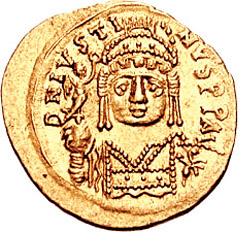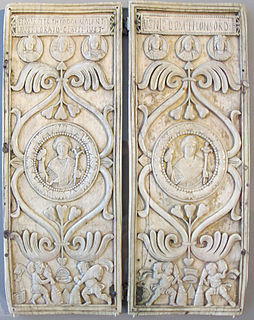Related Research Articles
The 500s decade ran from January 1, 500, to December 31, 509.
The 560s decade ran from January 1, 560, to December 31, 569.
The 570s decade ran from January 1, 570, to December 31, 579.
The 580s decade ran from January 1, 580, to December 31, 589.

Year 629 (DCXXIX) was a common year starting on Sunday of the Julian calendar. The denomination 629 for this year has been used since the early medieval period, when the Anno Domini calendar era became the prevalent method in Europe for naming years.

Year 608 (DCVIII) was a leap year starting on Monday of the Julian calendar. The denomination 608 for this year has been used since the early medieval period, when the Anno Domini calendar era became the prevalent method in Europe for naming years.

Year 573 (DLXXIII) was a common year starting on Sunday of the Julian calendar. The denomination 573 for this year has been used since the early medieval period, when the Anno Domini calendar era became the prevalent method in Europe for naming years.

Year 586 (DLXXXVI) was a common year starting on Tuesday of the Julian calendar. The denomination 586 for this year has been used since the early medieval period, when the Anno Domini calendar era became the prevalent method in Europe for naming years.

Year 579 (DLXXIX) was a common year starting on Sunday of the Julian calendar. The denomination 579 for this year has been used since the early medieval period, when the Anno Domini calendar era became the prevalent method in Europe for naming years.

Year 642 (DCXLII) was a common year starting on Tuesday of the Julian calendar. The denomination 642 for this year has been used since the early medieval period, when the Anno Domini calendar era became the prevalent method in Europe for naming years.

Year 616 (DCXVI) was a leap year starting on Thursday of the Julian calendar. The denomination 616 for this year has been used since the early medieval period, when the Anno Domini calendar era became the prevalent method in Europe for naming years.

Year 730 (DCCXXX) was a common year starting on Sunday of the Julian calendar. The denomination 730 for this year has been used since the early medieval period, when the Anno Domini calendar era became the prevalent method in Europe for naming years.

Maurice was Byzantine emperor from 582 to 602. A prominent general, Maurice fought with success against the Sasanian Empire. After he became Emperor, he brought the war with Sasanian Persia to a victorious conclusion. Under him the Empire's eastern border in the South Caucasus was vastly expanded and, for the first time in nearly two centuries, the Romans were no longer obliged to pay the Persians thousands of pounds of gold annually for peace.

Justin II or Justin the Younger was Eastern Roman Emperor from 565 to 574. He was the nephew of Justinian I and the husband of Sophia, the niece of the Empress Theodora, and was therefore a member of the Justinian Dynasty. His reign was marked by war with the Sassanid Empire, and the loss of the greater part of Italy. He presented the Cross of Justin II to Saint Peter's, Rome.

Tiberius II Constantine was Eastern Roman emperor from 574 to 582. Tiberius rose to power in 574 when Justin II, prior to a mental breakdown, proclaimed Tiberius Caesar and adopted him as his own son. In 578, Justin II, before he died, gave him the title of Augustus, under which title he reigned until his death on 14 August 582.

The Byzantine–Sasanian War of 572–591 was a war fought between the Sasanian Empire of Persia and the Eastern Roman Empire, termed by modern historians as the Byzantine Empire. It was triggered by pro-Byzantine revolts in areas of the Caucasus under Persian hegemony, although other events also contributed to its outbreak. The fighting was largely confined to the southern Caucasus and Mesopotamia, although it also extended into eastern Anatolia, Syria, and northern Iran. It was part of an intense sequence of wars between these two empires which occupied the majority of the 6th and early 7th centuries. It was also the last of the many wars between them to follow a pattern in which fighting was largely confined to frontier provinces and neither side achieved any lasting occupation of enemy territory beyond this border zone. It preceded a much more wide-ranging and dramatic final conflict in the early 7th century.

Flavius Mar. Petrus Theodorus Valentinus Rusticius Boraides Germanus Iustinus, simply and commonly known as Justin, was an East Roman (Byzantine) aristocrat and general. A member of the Justinian Dynasty and nephew of Emperor Justinian I, he was appointed as one of the last Roman consuls in 540, before going on to assume senior military commands in the Balkans and in Lazica. He fought against the Slavs, the Sassanid Persians and supervised the Byzantine Empire's first contacts with the Avars. At the time of Justinian's death, he was seen as a probable successor, but was beaten to the throne by his cousin, Justin II, who exiled him to Egypt, where he was murdered.
Justinian was an East Roman (Byzantine) aristocrat and general, and a member of the ruling Justinian dynasty. As a soldier, he had a distinguished career in the Balkans and in the East against Sassanid Persia. In his later years, he plotted unsuccessfully against regent and later emperor Tiberius II.
The 600s decade ran from January 1, 600, to December 31, 609.
Mahbod, was a 6th-century Iranian ambassador and military officer from the House of Suren, who was active during the reign of the Sasanian shahanshahs Khosrow I and Hormizd IV.
References
- ↑ Tiberius II Constantine [ permanent dead link ].
- ↑ Greatrex & Lieu 2002 , p. 136.
- ↑ Lombard (2008).
- ↑ Esposito (2003). The Oxford Dictionary of Islam, ISBN 0-19-512558-4.
- ↑ Connor, Steve (July 7, 2014). "Our explosive past is written in the Antarctic ice". i . London. p. 17.
- ↑ Connolly, S. J. (ed.). The Oxford companion to Irish history (2nd ed.). Oxford University Press. p. 5. ISBN 9780199691869.
- Bibliography
- Greatrex, Geoffrey; Lieu, Samuel N. C. (2002). The Roman Eastern Frontier and the Persian Wars (Part II, 363–630 AD). New York, New York and London, United Kingdom: Routledge (Taylor & Francis). ISBN 0-415-14687-9.